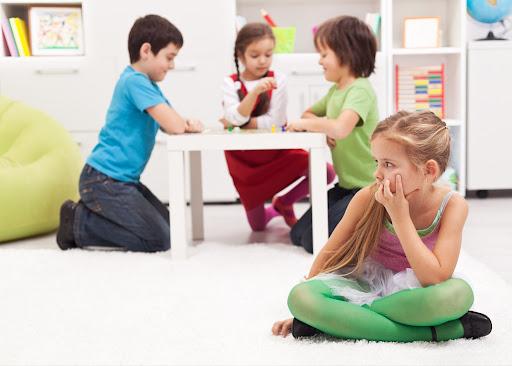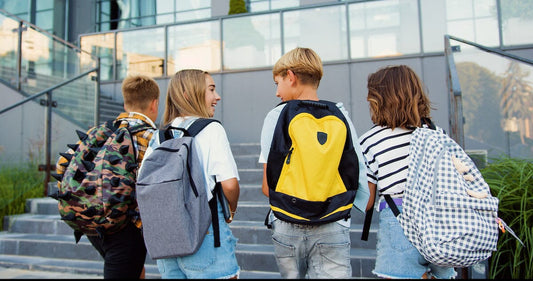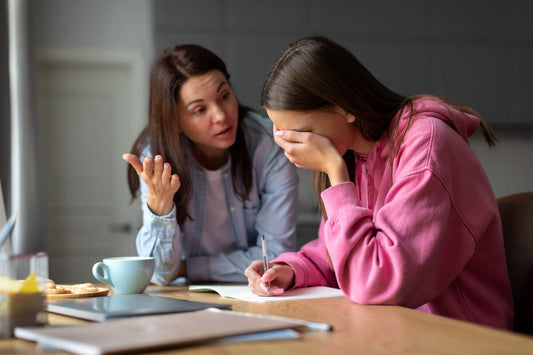If you notice that your child is having difficulty connecting with their peers or becoming incredibly upset before social gatherings, you may be wondering if they are suffering from social anxiety. More severe than shyness, social anxiety can have a devastating impact on your child’s academic performance, relationships, and self-esteem. Here is what you should know about how social anxiety differs from shyness, and what you can do to help your child cope.
Social Anxiety & Shyness Difference
Is social anxiety the same thing as being shy? According to experts, it is not. Social anxiety is far more severe and debilitating, which is why it is classified as a chronic mental health condition in the DSM-5. In his paper “Social Anxiety: More Than Just a Little Shyness,” James W. Jefferson, M.D. defines social anxiety as a “marked and persistent fear of social or performance situations in which embarrassment may occur.”1,2 It is often accompanied by symptoms such as sweating, palpitations, shaking, and respiratory distress. Jefferson points out that while the dividing line between social anxiety disorder and shyness is not always clear, the former causes severe distress and often interferes with relationships and functioning, while the latter is far less disruptive. While anyone can be shy from time to time depending upon the situation, social anxiety is so intense that it typically leads to a pattern of avoidance in many areas of a person’s life. While feelings of shyness may dissipate after a triggering situation has passed, social anxiety typically does not go away on its own, with symptoms worsening if the condition remains unaddressed.
Can Shyness Lead to Social Anxiety?
While shyness in childhood could be a precursor for social anxiety later in life, this is not always the case. Like introversion, shyness is best described as a personality trait, while social anxiety is seen as a diagnosable mental health condition. This is especially true for children, who are just figuring out their comfort levels in social situations, which may get easier with more familiarity. While a shy child or teen may never particularly like being the center of attention, their shyness will not typically interfere with their schoolwork, their willingness to try new things, or their ability to form close relationships. More common causes for social anxiety include a family history of anxiety, an overactive amygdala in the brain, or negative experiences like bullying or social rejection.3
Signs Your Child Has Social Anxiety
According to the Anxiety & Depression Association of America, social anxiety is typically evident around 13 years old.4 However, some research shows that childhood social anxiety disorder has affected 3- 6.8 percent of pediatric patients.5 In order for social anxiety to be diagnosable in a child, the anxiety must occur in settings with peers and not just with adults, and must last for six months or more.6 If you suspect your child has social anxiety, look out for the following signs:
- Intense fear of performance (including speaking in front of the class or performing in plays, musicals, etc.), which may be apparent in the weeks and possibly months leading up to a performance, potentially interfering with eating and sleeping habits
- Fear of interacting with same-age peers, including making casual conversation
- Somatic symptoms like headaches, stomachaches, nausea, shaking, sweating, blushing, and being short of breath due to anxiety
- Pervasive pattern of avoidance
- Selective mutism, in which children are unable to speak in triggering situations despite speaking normally in comfortable ones
Signs Your Teen Has Social Anxiety
According to the National Institute of Mental Health, an estimated 9.1 percent of adolescents in the U.S. have social anxiety disorder, with an estimated 1.3 percent having severe impairment.7 With increased academic and social pressures, there are various triggers for teens battling social anxiety, and some behaviors like social media use may exacerbate symptoms. If you suspect your teen is struggling with social anxiety, look out for these signs and symptoms:8
- Intense fear of performance with excessive worry in the weeks or months leading up to an event
- Appearing withdrawn, dependent, or uneasy in social settings
- Seeming overly restrained or emotional
- Preoccupied with worries about losing control or social competence
- Somatic symptoms like muscle tension and cramps, stomachaches, headaches, pain in the limbs and back, fatigue, discomforts associated with pubertal changes, flushing, sweating, hyperventilating, trembling, and startling easily
- Avoiding their usual activities or refusing to engage in new experiences
- Engaging in risky behaviors, such as drug experimentation or impulsive sexual behavior
Social Anxiety & COVID-19
One of the most common treatment plans for social anxiety involves exposure to feared situations. However, with COVID-19 ushering in school closures and social distancing, most of these feared situations were put to a halt. In a recent study, researchers suggested that clinicians continue treating socially anxious individuals by exposing them to social and performance situations using virtual means.9 But for some kids, even those without social anxiety, virtual learning can make anxiety symptoms worse. From tech complications to webcam phobia, there are plenty of triggers for children and teens when it comes to virtual learning. Clinical psychologist Kate Eshleman, PsyD tells the Cleveland Clinic that parents should be proactive in modeling calmness for their child, helping them plan ahead, assisting them in getting prepared for the webcam, and avoiding “toxic positivity.”10 Allowing your anxious child or teen to express frustration will help them feel heard while dealing with this new and unideal way of learning.
How to Help Your Child/Teen Overcome Social Anxiety
There are many different avenues you can take to help your child or teen deal with social anxiety. From cognitive behavioral therapy (CBT) to medication, here are some of the most common ways you can help:
- CBT: This method of therapy helps to change distorted thinking and dysfunctional behavior; when it comes to anxiety, one of the most effective CBT techniques is exposing kids to upsetting triggers in incremental steps so that they become more accustomed to them and less anxious
- Relaxation and mindfulness: From mindful breathing to progressive muscle relaxation, there are various tools you can teach your child (or practice with them) to use when feeling anxious
- Brainstorm solutions: When your child is expressing excessive worry over situations, have them point out exactly what is causing their anxiety; once you know what the worries are, you can brainstorm solutions together to help them feel more at ease
- Help them be a good friend: You can’t follow your child around all day and help them make friends directly, but you can teach them what being a good friend entails, including how to make friendly conversation and hold eye contact, which you can practice at home
While some doctors prescribe medication to treat social anxiety, such as selective serotonin reuptake inhibitors (SSRIs), these drugs often produce common side effects like insomnia, headaches, and stomach upset.11 Homeopathic medication like Brillia offers a gentle and impactful approach to reducing anxiety and irritability without producing any harmful side effects. Unlike SSRIs, which contain synthetic chemicals, the active ingredient in Brillia consists of antibodies to the brain-specific S100 protein (S100B), an important regulator of various different intracellular and extracellular brain processes. This protein binds to specific targets in the brain to prevent symptoms of anxiety without affecting any other systems in the body. Brillia is part of a multi-faceted holistic approach, which relies on healthy lifestyle factors like proper nutrition, adequate sleep, controlled screen time, and mindfulness practices to provide long-term relief from stress and anxiety.
Learn more about how Brillia works here.
Erica Garza is an author and essayist from Los Angeles. She holds an MFA from Columbia University and a certificate in Narrative Therapy. Her writing has appeared in TIME, Health, Glamour, Good Housekeeping, Women's Health, and VICE.


 Improve focus and clarity.
Improve focus and clarity.

